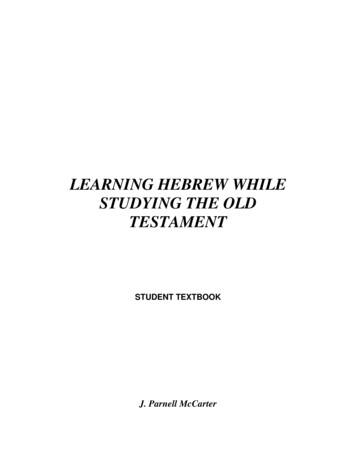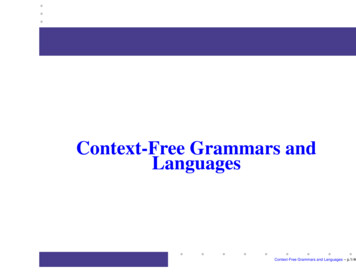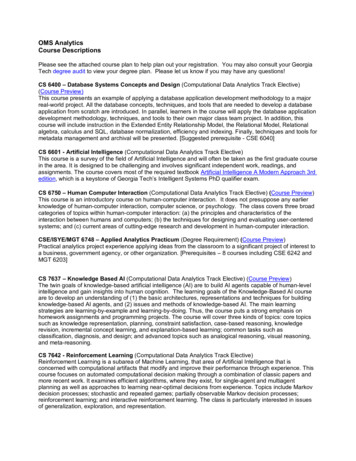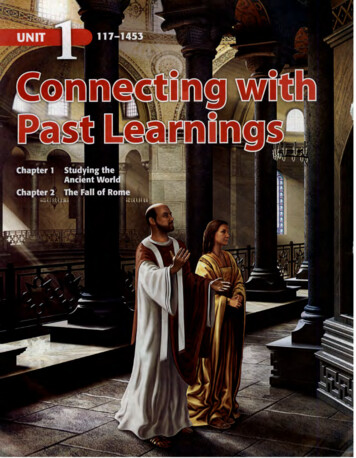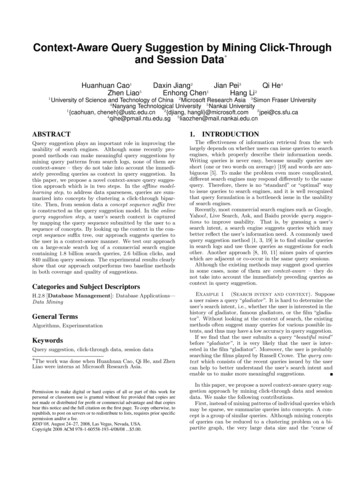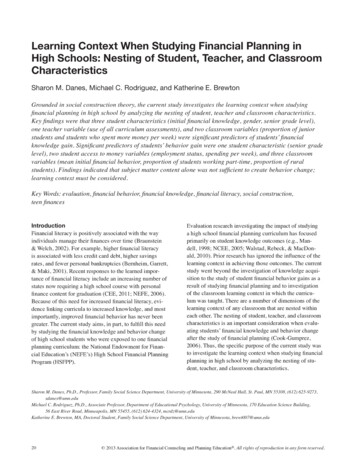
Transcription
Learning Context When Studying Financial Planning inHigh Schools: Nesting of Student, Teacher, and ClassroomCharacteristicsSharon M. Danes, Michael C. Rodriguez, and Katherine E. BrewtonGrounded in social construction theory, the current study investigates the learning context when studyingfinancial planning in high school by analyzing the nesting of student, teacher and classroom characteristics.Key findings were that three student characteristics (initial financial knowledge, gender, senior grade level),one teacher variable (use of all curriculum assessments), and two classroom variables (proportion of juniorstudents and students who spent more money per week) were significant predictors of students’ financialknowledge gain. Significant predictors of students’ behavior gain were one student characteristic (senior gradelevel), two student access to money variables (employment status, spending per week), and three classroomvariables (mean initial financial behavior, proportion of students working part-time, proportion of ruralstudents). Findings indicated that subject matter content alone was not sufficient to create behavior change;learning context must be considered.Key Words: evaluation, financial behavior, financial knowledge, financial literacy, social construction,teen financesIntroductionFinancial literacy is positively associated with the wayindividuals manage their finances over time (Braunstein& Welch, 2002). For example, higher financial literacyis associated with less credit card debt, higher savingsrates, and fewer personal bankruptcies (Bernheim, Garrett,& Maki, 2001). Recent responses to the learned importance of financial literacy include an increasing number ofstates now requiring a high school course with personalfinance content for graduation (CEE, 2011; NEFE, 2006).Because of this need for increased financial literacy, evidence linking curricula to increased knowledge, and mostimportantly, improved financial behavior has never beengreater. The current study aims, in part, to fulfill this needby studying the financial knowledge and behavior changeof high school students who were exposed to one financialplanning curriculum: the National Endowment for Financial Education’s (NEFE’s) High School Financial PlanningProgram (HSFPP).Evaluation research investigating the impact of studyinga high school financial planning curriculum has focusedprimarily on student knowledge outcomes (e.g., Mandell, 1998; NCEE, 2005; Walstad, Rebeck, & MacDonald, 2010). Prior research has ignored the influence of thelearning context in achieving those outcomes. The currentstudy went beyond the investigation of knowledge acquisition to the study of student financial behavior gains as aresult of studying financial planning and to investigationof the classroom learning context in which the curriculum was taught. There are a number of dimensions of thelearning context of any classroom that are nested withineach other. The nesting of student, teacher, and classroomcharacteristics is an important consideration when evaluating students’ financial knowledge and behavior changeafter the study of financial planning (Cook-Gumprez,2006). Thus, the specific purpose of the current study wasto investigate the learning context when studying financialplanning in high school by analyzing the nesting of student, teacher, and classroom characteristics.Sharon M. Danes, Ph.D., Professor, Family Social Science Department, University of Minnesota, 290 McNeal Hall, St. Paul, MN 55108, (612) 625-9273,sdanes@umn.eduMichael C. Rodriguez, Ph.D., Associate Professor, Department of Educational Psychology, University of Minnesota, 170 Education Science Building,56 East River Road, Minneapolis, MN 55455, (612) 624-4324, mcrdz@umn.eduKatherine E. Brewton, MA, Doctoral Student, Family Social Science Department, University of Minnesota, brewt007@umn.edu20 2013 Association for Financial Counseling and Planning Education . All rights of reproduction in any form reserved.
This study contributes to the literature in a number ofways. First, it incorporates pre-study measures of financial knowledge and behavior that high school studentshave socially constructed through various social milieusprior to studying the curriculum (McCormick, 2009). Acritical time to impact financial literacy is high school,because it is a time when social meanings and realities arebeing shaped (Gudmunson & Danes, 2011). It is a timewhen students begin to earn their own money, manage thatmoney independently from parents, and make short- andlong-term financial goals (Beutler & Dickson, 2008; Gudmunson & Beutler, 2012). Students’ unique characteristicsthat are rooted in the family environment (Danes, 1994)have the potential to deeply impact how they approach andinteract with personal finance curricula in their classrooms.In short, high school students bring individual meaningsand realities to their learning context (Berger & Luckmann, 2011). Further, research suggests that a majority ofparents leave their children’s financial education to the formal education system (American Savings Education Council, 2001), and high school is often students’ first exposureto formal personal finance curricula.Evaluation research on high school student financial planning knowledge and behavior acquisition has focusedprimarily on within-classroom results. Adding to the current literature, the study investigated both within- andbetween-classroom outcomes. Part of the reason that learning context and between-classroom results have not beenpreviously studied is partially due to limitations of analytical software that could not analyze the nested nature ofstudent, teacher, and classroom characteristics. However,hierarchical linear modeling now allows for this nesting ofdata and was the analytical procedure utilized in the study(Raudenbush & Bryk, 2002; Woltman, Feldstain, MacKay,& Rocchi, 2012). With the introduction of this analyticalsoftware, one of the deterrents to the investigation of learning context has been eased.The third literature contribution is that the study conceptually distinguished between behaviors and outcomes.Behaviors (e.g., saving money regularly) and outcomes(e.g., increased savings) are not the same thing (Xiao,2008). Behaviors only contribute partly to outcomes,because they result from both one’s behavior and otherfactors in many situations (Ajzen & Fishbein, 1980). Forexample, a high school student who works part time maywant to save money for future education, but saving substantial amounts of their earnings may not be possiblebecause their low income family or their ethnic values mayJournal of Financial Counseling and Planning Volume 24, Issue 2 2013require them to contribute most of their earnings to rentand other family necessities. The study focused on positivefinancial behaviors through using a competency-based curriculum with assignments and assessments where studentswere expected to demonstrate their ability to perform specified financial behaviors.Description of the Competency-Based HighSchool Financial Planning ProgramEvaluation data from high school students who studied NEFE’s HSFPP were used in the study. The HSFPPacquaints students with basic financial planning conceptsand illustrates how these concepts apply to everyday life.The curriculum goal is to increase the financial planningliteracy of teens. The hallmark of the curriculum is that itis competency-based, meaning that achievement of competencies (i.e., behaviors) is emphasized. Knowledge acquisition is a curriculum facet, but demonstration of each unitcompetency is its core organizing principle.The curriculum is divided into seven units, with each unitbuilding upon the previous one: (1) Your Financial Plan:Where It All Begins, (2) Budgeting: Making the Most ofYour Money, (3) Investing: Making Money Work for You,(4) Good Debt, Bad Debt: Using Credit Cards Wisely, (5)Your Money: Keeping It Safe and Secure, (6) Insurance:Protecting What You Have, and (7) Your Career: DoingWhat Matters Most. Each unit contains an overview usingexamples and language common to high school students, agoal statement identifying the main focus of the unit, andlearning objectives indicating the degree of mastery students are expected to demonstrate. Corresponding to eachunit are competency-based assignments and at least oneassessment designed to assess students’ ability to applywhat they learn (see Table 1).The HSFPP is free of charge and comes with an extensive Instructor’s Manual and Student Guide. The program can be taught in as few as 10 classroom hours, butit is not uncommon for it to be taught over a much longertime period. In fact, nearly 50% of teachers in the currentstudy dedicated 10 or more weeks to teaching the curriculum content. About 18% of teachers devoted four tonine weeks to the HSFPP content, while 12% taught it intwo to three weeks.Theoretical GroundingSocial construction theory guided the current research.When social construction theory is applied to financialliteracy acquisition in high schools, learning context is a21
Table 1. Units, and Competency-Based Assignments and Assessments in the NEFE HSFPPUnits1. Your Financial Plan: Where It All BeginsAssignments1. My SMART Goals2. 30-Day Countdown to Goal3. My Personal Spending Log4. Decisions, Decisions5. Financial Planning Strategies6. Financial Planning Process StepsAssessmentsMy Financial Plan2. Budgeting: Making the Most of Your Money 1. How Am I Doing?2. My Fixed and Variable Expenses3. Saving for My Goals4. Build a BudgetMy Personal Budget4. Good Debt, Bad Debt: Using Credit Wisely 1. FAQs About Credit2. Compare Phone Plans3. My 4 C’s of Credit4. Please Correct My Credit ReportMy Plan to Handle Credit6. Insurance: Protecting What You HaveMy Insurance Plan3. Investing: Making Money Work for You5. Your Money: Keeping It Safe and Secure7. Your Career: Doing What Matters Most1. Time Value of Money2. Which Is the Best Deal?3. My Investing Options4. My Risks and Rewards1. Shopping for My Financial Services Provider Use Financial Services2. Use a Checking Account3. Choosing a Credit Card4. What Are the Trends?5. Online Warnings1. A Case for Insurance2. My Personal Financial Risk Exposure3. Insure the Car of Your Dreams1. My Marketable Skills2. My Career Prep3. My Job Benefitsmajor theory concept (Cook-Gumperz, 2006). The theoryis composed of four central assumptions when applied tothe classroom learning context: (a) learning occurs not justthrough objective, unbiased observation but through critical thinking and application, (b) learning is historically andculturally specific, (c) learning is sustained by social processes, and (d) learning and social interaction go together.Each of these assumptions was investigated.When applying social construction’s first assumption tofinancial literacy acquisition, the shaping of social meanings and realities about money is not based entirely onobjective and unbiased world observations but throughcritical thinking and application (Burr, 2003). Social con-22My Investing PlanPlanning for My Careerstruction theory posits that content alone in learning is notsufficient to create behavior change, but that content application through instructional activities and classroom practices creating student interaction establishes a deeper integration of learning (Cook-Gumperz, 2006). One way thecurrent study addressed this assumption was by measuring the use of competency-based assignments and assessments. Each of the chapter assignments and assessmentswas designed to evaluate the achievement of a particularbehavior competency related to the chapter content.The second social construction assumption states thatlearning is historically and culturally specific. As part ofthe learning context in studying financial planning, stu-Journal of Financial Counseling and Planning Volume 24, Issue 2 2013
dents bring varying characteristics and experiences, someof which come from their families (Danes & Haberman,2007; Gudmunson & Danes, 2011). For example, differingcommunication patterns and the amount of parent-childcommunication affect the endorsement of materialistic values (Chan & Prendergast, 2007). More specifically, Allen(2008) explained that concept-oriented parents (encouraging debate, rational discussion, and creative thinking) weremore likely to purchase goods rationally rather than buying due to social needs, to display more discontent withthe products they purchased, and to develop and articulatean independent consumption perspective. On the otherhand, those raised by socio-oriented parents (encouragingconformist thinking and emphasizing family harmony andacceptance of authority) were more likely to grow up todepend more on mass media content and peer conversation for consumer information. The current study measuredthe pre-study student financial knowledge and behavior toaddress what students bring into their classroom including what had emanated from the cultures in which theyare grounded (family, gender, work, hometown location,and peer environments). The classroom in which teachers instruct, as well, is grounded in an educational culture(e.g., whether financial planning is a state mandate); thisclassroom culture has been found to significantly influence students’ financial socialization (Bartholomae & Fox,2002). Such other factors as teacher confidence in teachingfinancial planning, the number of hours the teacher teachesthe subject content, and the years of teaching experienceare also part of the classroom culture that may affect student outcomes (Danes & Haberman, 2007).The fourth theory assumption is that learning and socialinteraction go together. In a competency-based learning curriculum such as NEFE’s HSFPP, where behaviorchange is the key target rather than merely knowledgeaccumulation, student and teacher interactions createshared understandings and underpinnings for lifelongbehavior patterns (outcomes as defined by Ajzen & Fishbein, 1980). Behavior acquisition resulting from competency-based education is performance-based (Curran etal., 2009). As such, both instruction and assessment areorganized around student acquisition of positive financialbehaviors and emphasize behavior change in addition toknowledge gain (Chyung, Stepick, & Cox, 2006).The third assumption of social construction theory stipulates that learning is sustained by social processes. Classrooms are places where values, beliefs, attitudes, expectations, and motivations about money are stimulated ifthey do not already exist, or if they do already exist fromsocialization in other contexts, those values, beliefs, attitudes, expectations and motivations are further verified orchallenged (Beutler & Dickson, 2010). Classrooms are asocial context where students interact with their existinginternalized norms instilled by families (Danes & Haberman, 2007; Gudmunson & Beutler, 2012). Thus, in addition to the strong influence that the parental learning has inshaping children’s financial behaviors and attitudes, financial knowledge and behavior acquisition achieved throughthe classroom learning context have also shown to influence youth in important ways (Shim, Barber, Card, Xiao,& Serido, 2010).Student CharacteristicsA distinguishing component of Danes and Brewton’s(2010) mixed-methods evaluation of NEFE’s HSFPP wasthat it explored the role of learning context on students’financial knowledge and behavior outcomes in an attemptto determine the relevance of the content to students ofvarying backgrounds. Findings showed that while male,farming, and working students had higher financial knowledge pre-study, it was female, non-farming, and non-working students who gained more from it. Moreover, studentsin classrooms that mandated financial education and thosenot living on farms gained more from the curriculum thantheir counterparts on nearly every financial behavior. Ascant amount of studies not connected to NEFE’s HSFPPhave been conducted to explore the role of context on highschool students’ learning and/or behavior, and these studiesare reviewed, and organized by student characteristic.Journal of Financial Counseling and Planning Volume 24, Issue 2 2013Literature ReviewMixed results exist as to whether studying personal financein high school affects students’ financial literacy. In severalJump tart surveys, high school seniors taking a full-semester high school class in personal finance were nomore financially literate than students who did not take acourse (Mandell, 2008). However, increases in financialknowledge (Walstad, et al., 2010) and increases in financial behavior (Danes & Haberman, 2007, Danes, Huddleston-Casas, & Boyce, 1999) were found when a specifically identified curriculum was studied and the evaluationwas carefully implemented and grounded in evaluationtheory (Jacobs, 1988). Because the current study’s purpose was to investigate the learning context when studyingfinancial planning in high school by analyzing the nestingof student, teacher, and classroom characteristics, the literature review is organized around those characteristics.23
Students’ ethnicity statusResearchers have established a link between ethnicity andfinancial literacy. Lucey and Giannangelo (2006) showedthat minority students generally had much lower levels offinancial knowledge compared to their White peers. A similar finding was reported in the 2006 Jump tart survey ofhigh school seniors (Mandell, 2008). In a separate analysisof African American students from that 2006 survey, financial literacy was found not to be related to family income,but the study suggested that African American teens mightbe missing opportunities to develop money managementskills because a lower proportion of them worked part timein the summer (Bowen, 2008). Also, African American andHispanic female students tended to be more financiallyat risk for credit card debt compared to their counterparts(Johnson & Sherraden, 2007). Despite initial ethnic differences in financial knowledge and behavior, Peng, Bartholamae, Fox, and Cravener (2007) found no differencesbetween White and non-White students following a personal finance course.Hometown locationValentine and Khayum (2005) tested financial knowledgedifferences between rural and urban high school studentsand found no overall differences between the two groups.Differences were found in regards to specific personalfinance topic areas, however. Specifically, financial knowledge of urban highschoolers was higher than that of ruralhighschoolers in topic areas of housing rentals and foodpurchases, while rural students, on average, achievedhigher scores than urban students in the topic area of automobile insurance.Students’ genderOf the distinguishing student characteristics known to possibly affect financial literacy, gender has been studied tothe greatest extent. Danes and Haberman (2007) found thatfemale high school students gained more knowledge oncredit, auto insurance, and investments than did the malestudents after studying financial planning, but male studentshad more knowledge entering the course. Females believedthat managing money affected their future more than males,but males felt more confident making money decisions.After studying the curriculum, males reported achieving financial goals more than females, whereas femalesreported using budgets, comparing prices, and discussingmoney with family more than males. In sum, as a result ofthe study, male teens reinforced their existing knowledge,whereas female teens learned significantly more aboutfinances in areas in which they were unfamiliar.24In another study, Varcoe, Martin, Devitto, and Go (2005)found that male high school students’ knowledge increasedmore than females’ after studying personal finance. Further, Lusardi, Mitchell, & Curto (2010) found that femalesfrom ages 12 to 15 were less knowledgeable about interestrates, inflation, and risk diversification than males of thatage; that difference persisted after controlling for manydemographic, family background, and peer characteristics.Grade levelThe majority of financial literacy research in high schoolsis conducted with juniors and seniors rather than freshmenand sophomores. Personal finance is usually taught thenand there is a belief that these older high school studentsare about ready to live on their own, and, thus, they willfind the content more relevant. Researchers have generally found that teens have low levels of financial literacy,and despite recent attention to the importance of financialliteracy, literacy scores have not improved (Mandell &Klein, 2007). Thus, there has been a call to teach personalfinance content earlier in high school because of the content’s importance and because drop-out rates increase asstudents progress in school (McCormick, 2009).Teacher CharacteristicsA knowledge gap exists in demonstrating how teachers affect their students’ financial knowledge and behavior outcomes. Understanding how teachers’ instructionaffects study outcomes when studying financial planningis important because the manner in which teachers choosecurricula and utilize those curricula has the potential toultimately affect the way that teachers instruct and whatstudents gain from their courses (Cook-Gumperz, 2006).Way and Holden (2009) studied an initial dimension ofthis premise by focusing on teachers’ backgrounds andcapacity to teach personal finance. The authors found thatK-12 personal finance teachers tended to be female (75%)and only slightly more than one third of them reported thatthey had ever taken college coursework with any financialeducation-relevant content. With regard to their estimationof their competency to teach personal finance, relativelyfew teachers reported feeling very competent to teach personal finance. The topic areas for which teachers reportedfeeling most competent to teach were income and careers,and planning and money management, but fewer than 20%selected the “very well prepared” option in these areas.Teachers reported feeling least competent in the more specific areas of risk management and insurance, saving andinvesting, and financial responsibility and decision-making. Over half of the teachers felt “not very competent” toJournal of Financial Counseling and Planning Volume 24, Issue 2 2013
teach risk management and insurance, and nearly half felt“not very competent” to teach about saving and investing. In states where educational testing or courses aremandated, teachers expressed no difference in teachingcompetency compared to teachers in states where personalfinance was not mandated.The Way and Holden (2009) findings are quite importantin that teacher content expertise research from other disciplines, such as math, reading, and science education, haveindicated that well-qualified teachers are those teachers witha degree in the subject matter being taught (U.S. Departmentof Education, 2004). These “well-qualified” teachers produced the greatest achievement gain in their students.Student Access to MoneyPart of high school students’ unique context is their accessto money. Employment, weekly spending, and debt accumulation are directly related to money accessibility. Ahandful of research studies address how these factorsaffect financial knowledge and behavior.Students’ working statusThere is little known about how working status affectshigh school students’ financial knowledge and behaviorafter exposure to personal finance curricula, and whenstudied, the findings were not consistent. Worthington(2004) found that non-working individuals generally havelower financial knowledge than working individuals. Valentine and Kharyum (2005) found that working up to 20hours per week (i.e., part time) was positively related tooverall scores on a financial literacy quiz. On the otherhand, Walstad et al. (2010) found that with exposure tofinancial education, employed high schoolers’ behaviordid not differ from non-employed highschoolers’ behavior. Erskine, Kier, Leung, and Sproule (2006) found thathigh school students who worked, whether full time or parttime, saved more money than non-working students. Thesesame authors further discovered that students who workedpart-time were more likely to save money for future education than those students working full-time.SpendingFollowing exposure to NEFE’s HSFPP, Danes, Huddleston-Casas, and Boyce (1999) found that, in the shortrun, self-reported financial behavior improved immediately after exposure to the curriculum. They conducteda 3-month follow-up survey and found that over half ofthe respondents reported making positive changes to theirspending habits. Grimes, Rogers, and Smith (2010) foundJournal of Financial Counseling and Planning Volume 24, Issue 2 2013that taking an economics course in high school positivelyinfluenced an individual’s decision to maintain a bankaccount in later life.Debt statusHigh school students accumulate debt through use of creditcards that are in their own name, formal loans with banksor credit unions, and informal loans with family membersand friends. In a study of high schoolers studying personalfinance (Danes & Haberman, 2007), 23% of male students and 27% of female students had debts. There was asignificant difference between the genders regarding debtlevels owed. Males owed 1,040 and females owed 504,on average. Students who had purchased a car or motorcycle had formal loans from a bank or credit union. Otherstudents had borrowed money from family members orfriends for such items as cell phones, stereos, TVs, computers, or gaming systems.The 2006 Jump tart survey found that 32% of high schoolseniors used a credit card (Mandell, 2008). More thanhalf of these students used a card in their own name whilein the Danes and Haberman (2007) study that includedmostly juniors and seniors in high school, about 8% had acredit card in their own name. Varcoe et al. (2002) foundthat teens were more interested in learning “how to getcredit” than about “what credit is” or the “consequences ofbad debt.”Teacher Use of CurriculaDanes, Huddleston-Casas, and Boyce, in 1999, and Danesand Brewton, in 2010, assessed the impact of NEFE’sHSFPP curriculum on the financial knowledge, behavior,and confidence of over 4,000 teens and found changes intheir financial knowledge, behavior, and confidence bothimmediately after and three months following programcompletion. Thus, there is evidence that competency-basedcurricula, such as the HSFPP, are effective. However,these evaluations also showed that, while many teachers presented the curriculum in its entirety, others did not.Presenting an abbreviated version of the curriculum maymean that those teachers’ students were not exposed toas much competency-based education as students whoseteachers presented the curriculum in its entirety. It is possible that this difference in context could result in differences in financial knowledge and behavior.MethodThe current study aimed to predict high school students’financial knowledge and behavior gains as a result of25
studying NEFE’s HSFPP using nested student, classroom,and teacher characteristics. In this section, procedures arediscussed first, followed by operational definitions of variables, and a description of the analytic procedures.Sampling ProceduresA sample of 2,300 teachers across the U.S. who requestedNEFE’s HSFPP for their classrooms were sent a 1-pageparticipation survey to determine intended use of the curriculum during the project timeframe, commitment to theevaluation project, class size, and intended ending date ofthe curriculum. Of the 1,062 surveys returned, many of theteachers did not plan to use the materials during the identified data collection period; others declined to participate orwere ineligible for the study.There were 299 teachers who anticipated teaching NEFE’sHSFPP in the timeframe of interest and were eligible andwilling to participate in the evaluation. Of these teachers,156 indicated that no school or district permission wasneeded to participate. Permission was required, however,for 143 schools. Appropriate staff at the 143 schools werecontacted by letter, email, and telephone to learn whatsteps needed to be taken to obtain permission. Requirements varied. Some school administrators requested copiesof the surveys and other project materials, some simplyhad a few questions for clarification, and some sent formsto be completed and returned. Some requirements wereso extensive and time-consuming that it was impracticalto pursue. Ultimately, permission was received from 130of the 143 schools. Teachers at the remaining 13 schoolsdid not participate, because official permission was notobtained. Teachers at the 130 schools from which permission was granted were mailed packets containing oneteacher survey and enough student surveys for those teachers’ anticipated students. In total, completed surveys werereceived from 212 teachers and 4,794 of their students;these teachers’ and students’ data were used in the study.Post-Then-Pre Method for Evaluating Financial Knowledge and BehaviorFinancial knowledge and behavior were assessed and usedin the current study using a post-then-pre method (Rockwell & Kohn, 1989). In comparison to the more traditional pre-test – post-test method, where pre-tests are givenbefore studying subject matter and post-tests are givenafter studying subject matter, the post-then-pre methodfirst asked students about their levels of financial knowledge and behavior post-study, and then, in the next set ofquestions, asked about their levels of pre-study financial26knowledge and behavior. Questions about what studentsknew and how they behaved prior to studying the curriculum were asked in past tense. Overall, the post-then-premethod took less time and was less intrusive than the pretest – post-test method and avoided the pre-test sensitivity and response shift bias that often results from pre-testoverestimation or underestimation (Lam & Bengo, 2003;P
School Financial Planning Program Evaluation data from high school students who stud-ied NEFE's HSFPP were used in the study. The HSFPP acquaints students with basic financial planning concepts and illustrates how these concepts apply to everyday life. The curriculum goal is to increase the financial planning literacy of teens. The hallmark .

